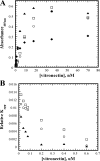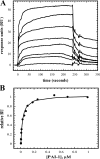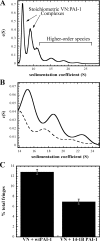A deletion mutant of vitronectin lacking the somatomedin B domain exhibits residual plasminogen activator inhibitor-1-binding activity
- PMID: 18174166
- PMCID: PMC2447658
- DOI: 10.1074/jbc.M708017200
A deletion mutant of vitronectin lacking the somatomedin B domain exhibits residual plasminogen activator inhibitor-1-binding activity
Abstract
Vitronectin and plasminogen activator inhibitor-1 (PAI-1) are important physiological binding partners that work in concert to regulate cellular adhesion, migration, and fibrinolysis. The high affinity binding site for PAI-1 is located within the N-terminal somatomedin B domain of vitronectin; however, several studies have suggested a second PAI-1-binding site within vitronectin. To investigate this secondary site, a vitronectin mutant lacking the somatomedin B domain (rDeltasBVN) was engineered. The short deletion had no effect on heparin-binding, integrin-binding, or cellular adhesion. Binding to the urokinase receptor was completely abolished while PAI-1 binding was still observed, albeit with a lower affinity. Analytical ultracentrifugation on the PAI-1-vitronectin complex demonstrated that increasing NaCl concentration favors 1:1 versus 2:1 PAI-1-vitronectin complexes and hampers formation of higher order complexes, pointing to the contribution of charge-charge interactions for PAI-1 binding to the second site. Furthermore, fluorescence resonance energy transfer between differentially labeled PAI-1 molecules confirmed that two independent molecules of PAI-1 are capable of binding to vitronectin. These results support a model for the assembly of higher order PAI-1-vitronectin complexes via two distinct binding sites in both proteins.
Figures







Similar articles
-
Characterization of a site on PAI-1 that binds to vitronectin outside of the somatomedin B domain.J Biol Chem. 2008 Oct 17;283(42):28487-96. doi: 10.1074/jbc.M804257200. Epub 2008 Jul 24. J Biol Chem. 2008. PMID: 18658131 Free PMC article.
-
Plasminogen activator inhibitor-1 regulates cell adhesion by binding to the somatomedin B domain of vitronectin.J Cell Physiol. 2001 Oct;189(1):23-33. doi: 10.1002/jcp.1133. J Cell Physiol. 2001. PMID: 11573201
-
Structural and functional analysis of the plasminogen activator inhibitor-1 binding motif in the somatomedin B domain of vitronectin.J Biol Chem. 1996 May 31;271(22):12716-23. doi: 10.1074/jbc.271.22.12716. J Biol Chem. 1996. PMID: 8662688
-
Interaction of plasminogen activator inhibitor type-1 (PAI-1) with vitronectin (Vn): mapping the binding sites on PAI-1 and Vn.Biol Chem. 2002 Jul-Aug;383(7-8):1143-9. doi: 10.1515/BC.2002.125. Biol Chem. 2002. PMID: 12437099 Review.
-
Regulation of cell adhesion by PAI-1.APMIS. 1999 Jan;107(1):54-61. doi: 10.1111/j.1699-0463.1999.tb01526.x. APMIS. 1999. PMID: 10190280 Review.
Cited by
-
Crystal structure of plasminogen activator inhibitor-1 in an active conformation with normal thermodynamic stability.J Biol Chem. 2011 Aug 26;286(34):29709-17. doi: 10.1074/jbc.M111.236554. Epub 2011 Jun 21. J Biol Chem. 2011. PMID: 21697084 Free PMC article.
-
Characterization of an Extensive Interface on Vitronectin for Binding to Plasminogen Activator Inhibitor-1: Adoption of Structure in an Intrinsically Disordered Region.Biochemistry. 2019 Dec 24;58(51):5117-5134. doi: 10.1021/acs.biochem.9b00605. Epub 2019 Dec 16. Biochemistry. 2019. PMID: 31793295 Free PMC article.
-
Metals affect the structure and activity of human plasminogen activator inhibitor-1. I. Modulation of stability and protease inhibition.Protein Sci. 2011 Feb;20(2):353-65. doi: 10.1002/pro.568. Protein Sci. 2011. PMID: 21280127 Free PMC article.
-
Cyr61/CCN1 displays high-affinity binding to the somatomedin B(1-44) domain of vitronectin.PLoS One. 2010 Feb 26;5(2):e9356. doi: 10.1371/journal.pone.0009356. PLoS One. 2010. PMID: 20195466 Free PMC article.
-
Characterization of a site on PAI-1 that binds to vitronectin outside of the somatomedin B domain.J Biol Chem. 2008 Oct 17;283(42):28487-96. doi: 10.1074/jbc.M804257200. Epub 2008 Jul 24. J Biol Chem. 2008. PMID: 18658131 Free PMC article.
References
-
- Preissner, K. T., and Muller-Berghaus, G. (1986) Eur. J. Biochem. 156 645–650 - PubMed
-
- Podor, T. J., Campbell, S., Chindemi, P., Foulon, D. M., Farrell, D. H., Walton, P. D., Weitz, J. I., and Peterson, C. B. (2002) J. Biol. Chem. 277 7520–7528 - PubMed
-
- Xu, D., Baburaj, K., Peterson, C. B., and Xu, Y. (2001) Proteins 44 312–320 - PubMed
-
- Mayasundari, A., Whittemore, N. A., Serpersu, E. H., and Peterson, C. B. (2004) J. Biol. Chem. 279 29359–29366 - PubMed
Publication types
MeSH terms
Substances
Grants and funding
LinkOut - more resources
Full Text Sources
Miscellaneous

